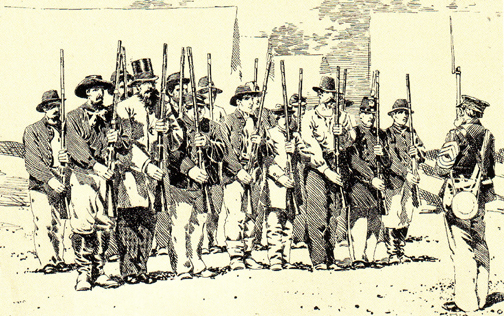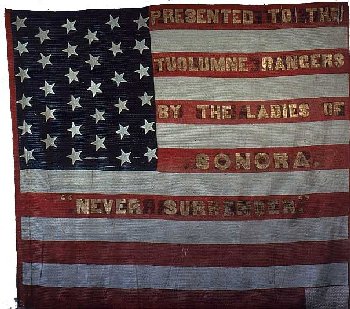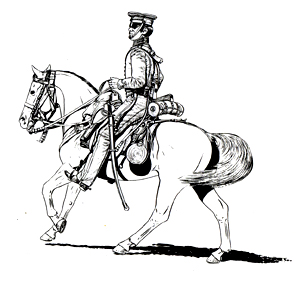COLUMBIA MILITIAS.
1850 to 1890



Columbia Militia.
AKA: militiamen, volunteers
of Columbia, Tuolumne County.
1852 July - rumors had flown that the Mexicans were going to poison a well at Saw Mill Flat and create other mayhem. Col. Thomas Cazneau headed a group of militiamen with a small cannon and proceeded to the Flat; firing the cannon every 100 yards or so. The action may have created the desired effect, except that the storekeeper in the Flat said he never had any trouble with Mexicans and that the whole affair was a waste of powder.
(SF Herald, June 8, 1853; H. H. Bancroft, California Inter Pocula, 1888; Republican, July 14, 1852; Alta, June 6, 1852.)
Letter from Saw Mill Flat, July 18, 1852.
"A word as to the 200 Americans from Columbia, ready to destroy the camp, and who would have done so but could not agree, & The truth is, reports had reached Columbia that we were to be attacked that night, and twenty men all told came over and volunteered to assist in our defence. This offer was thankfully and gratefully declined, being able, in our opinion, to defend ourselves against our foes. So ends, for the present, this great rebellion."
WILLIAM STACEY,
Saw Mill owner, Saw Mill Flat, of the firm of Stacey, Bennett & Turner.
(from the Daily Alta California, July 22, 1852, Pg. 1 Col. 6)

1854 January - The "Fusileers," occupy John Leary's Armory Hall.
1854 December 8 - Friday, Robert Bruce was hanged at Sonora, for the murder of a Mexican Indian boy, of sixteen. Just at noon Bruce was taken from the jail, placed in a carriage, in which the Sheriff and other officers were seated, and escorted to the place of execution, by the two military companies of Tuolumne, the Sonora Grays and the Columbia Fusiliers. (A History of Tuolumne County, California - B.F. Alley, 1882)
1855 August 3 - the day of execution for two murderers, between the hours of eleven and twelve o'clock the Columbia Fusileers and the Sonora Greys, two splendid looking, well equipped and strictly disciplined companies of volunteer troops, marched to the County Jail to act as escort for the prisoners, who were then placed in a carriage, their Catholic priest between, and driven to the gallows, accompanied by a dense mass of human beings, consisting of men, women and children. The place of execution was well selected for purposes of exhibition, for the gallows was erected on a small flat surrounded on every side by gently rising hills, and none who felt desirous of witnessing a human being writhing in his last death agonies could retire disappointed, for the view was full and complete...and they were on that day hanged in presence of a crowd of three thousand spectators. (A History of Tuolumne County, California - B.F. Alley, 1882)
In a meeting presided over by James Coffroth on December 23, 1853, the Columbia Fusileers were duly organized at Columbia, Tuolumne County, under the Military Laws of the State of California (see below). The term fusileer (or fusilier) originally applied to soldiers armed with a fusil (Fusil--a fire steel for a tinder box. A light musket or firelock). In the British Army the designation, fusileer, is still retained by ten regiments (as of this writing in 1940) distinguished from the other regiments of`the line only by wearing a kind of busby (Busby--a busby wig or hat) and other peculiarities in costume. This company was fortunate in having as commander, Captain Thomas Cazneau, one of California's most capable soldiers, and later made Adjutant General.
The records show: July 10, 1854, a fire completely destroyed the town of Columbia, and many of the officers and men suffered heavy property losses. Included in the loss was the armory and equipment belonging to the company. In one respect this fire was fortunate for it seemed to weld the members of the, Fusileer Company together, in a civic minded purpose, that of rebuilding the town and promoting interest for the betterment of their community.
A need for this organization's support to the civil authorities was seen in the late fifties, when the Sheriff was compelled.to call out the company to act as guard for Escobar and Sebado, two bandits who had been convicted of murdering Sheldon, a deaf and dumb mute. This execution was witnessed by more than four thousand men, women, and children, and by the presence of the Columbia Fusileers, law and order was maintained.(Sacramento Union, August 6, 1855, Page 3, Column 3) Two years later, the Fusileers again were forced to act in the grim role as guards for death, when on Friday, June 26, 1857, William V. Davis, who had been convicted of the murder of a Chinese immigrant in the vicinity of Stanislaus, was executed in the presence of a large crowd. The Columbia Fusileers, at the request of the civil authorities were on guard the entire day, the purpose being to protect the inmates imprisoned there, for fear of an attack by the citizens on the County Jail. (San Francisco Daily Herald, June 28, 1857, Page 3, Column 2.)

1857 June - The Columbia light Artillery was organized. This corps became quite a feature in the county, far outshinning the more common-place infantry. Commanded by Major J.B. Urmy, associate editor of the Tuolumne Courier. His subordinates being Lieutenant Hooker and Sergeants McDonald and leavitt. (A History of Tuolumne County, California - B.F. Alley, 1882 pg 130)


1861 Several companies of volunteer troops, infantry and cavalry, were organized for service in the war, the history of whom is interesting. The first organized was the famous Tuolumne Rangers, who were recruited in Columbia and vicinity, and of whom many were well-known and respected citizens. The Rangers numbered at the time of their departure for service one hundred and nine men all told, and were officered thus:
Captain, D. B. Akey; First Lieutenant, R. Daley; Second Lieutenant, S. R. Davis; Sergeants, J. L. Merriam, S. R. Murston and J. McCune. These troops, which were cavalry, were enlisted for service on the Overland Route, but going to San Francisco in September, 1861, they were stationed for a time at Camp Alert, forming a part of Colonel P. Edward Conner's Third Infantry Regiment, of California Volunteers, afterwards being transferred to Co. E, Second California Regiment of Cavalry.
The Rangers did not take a very prominent part in the war, but rendered good service to the Government in keeping the Indians in order, being for a long time stationed in Humboldt County, on the coast of California, and for a portion of the years of 1862-3 at Red Bluff, Tehama County.
(A History of Tuolumne County, California - B.F. Alley, 1882)


1861 No more details available.
(C.D.C. by H.E. Rensch - 1952)

1861 No more details available.
(C.D.C. by H.E. Rensch - 1952)

1861 No more details available.
(C.D.C. by H.E. Rensch - 1952)

Section 1: Whenever a sufficient number, by the provisions of this Act, of the citizens of any one county of this State, subject to military duty, shall wish to form themselves into a volunteer or independent company, it shall be the duty of the Judge of the County Court of such county to cause some suitable person, residing in such county, to open a book, in which he shall enter the names of all persons able to perform military duty, who may make application -e members of such company; and it shall be to become the duty of the person so appointed, to give notice, by publication in some newspaper or by posting up such notice in at least three of the most public places in such county, of the time and place such book shall be opened to receive the names of volunteers.
Section 2: As soon as such book shall be opened for volunteers, and the number in this Act required, subject to military duty, shall have volunteered, the person so appointed shall fix a time and place for the meeting of the same, by giving at least ten Days' notice thereof, by publication in some newspaper, or by posting up written notices in at least three of the. most public places in such county; and it shall be his duty to attend at such meeting; and present the book aforesaid, containing the names of the volunteers.
Section 3: It shall be the duty of the person so appointed, to attend and act as chairman of such meeting, and to organize the same. He shall call the name of each volunteer written in said book, and when all the members of said company are present, he shall give notice, by proclamation, that said company will forthwith proceed to an election of officers. Articles 4, 6 and 7 respectively, provide the procedure for the election of commissioned and non-commissioned officers. Quote:
Section 4: The members of the company so volunteering, shall then proceed to the choice of their commissioned and non-commissioned officers, and it shall be the duty of the person so appointed to take in writing the names of all persons nominated for election, and in connection with any other two or more persons determined on by a-majority of said company, to receive, and after all the members of the company present have voted to carefully count and add up the votes cast, and make proclamation of the names and rank of the persons elected. In the choice of officers, the election shall be by ballot.
Section 6: It shall be the duty of the person so appointed, after such election shall have been determined, to make out in writing and sign a certificate of election of each of the officers so elected, which certificate he shall deliver to the respective officers of the company. He shall also, within the next ten days, make out a return stating the time of the formation and organization of such company, its. name and numerical strength of rank and file, and the names of its commissioned and non-commissioned officers, and forthwith forward the same to the Adjutant General of this State.
Section 7: The volunteer or independent companies shall be armed and equipped in the same manner that similar corps are in the army of the United States and shall consist of the following officers, non-commissioned officers, musicians, and privates, to wit: To each company of cavalry there shall be one Captain, one first and two second Ueutenants, four sergeants, corporals, one saddler, one farrier, one trumpeter and not less than forty nor more than eighty privates. To all other volunteer or independent companies there shall be one captain, one first and two second lieutenants, four sergeants, four corporals, one drummer, one fifer, and not less than fifty nor more than one hundred privates. As was stated in the seventh article that "the volunteer companies were to be armed and equipped in the same manner that similar corps were in the Army of the United States", provision was made in the Act for the financing of these arms. *Articles 14 and 15 covered the petition for the arms which was accompanied by a Bond and the issuance of the ordnance stores. Quote:
Section 14: That from and after the passage of this Act, when any volunteer or independent company of artillery cavalry, infantry, or riflemen, shall become organized and uniformed, according to law, the Captain, or commanding officer, may petition the commander-in-chief to furnish him for the use of his company, with such a number of muskets, rifles, sabers, pistols, or other arms, with their accouterments, or in an artillery company, cannon or field pieces and swords, with their necessary accouterments and equipments, as his company may require, and set forth in said petition the brigade and county to which his company belongs,' the number it contains, and specific number and description of the arms and accouterments requisite for it, which shall not be greater than the rank and file his company shall contain: which petition shall be accompanied by a bond, payable to ihe Governor and his successors in office, for the use of the People of the State of California, in a penal sum of double the amount of the value of all the arms and accouterments so petitioned for, according to the prices at which they are rated by the United States, when furnishing them, and signed by himself as principal, with good and sufficient sureties, conditioned to safely keep, and have in readiness for use, the arms and accouterments by him received and to return them in good order, if at any time required so to do,which bond must be approved, as to. the sufficiency of the security, by the Judge of the County Court of the County where such company is formed; and his certificate thereof, together with the bond, shall be filed in the office of the Secretary of State.
Section 15: The commander-in-chief, upon application being made to him as aforesaid, shall, if there be any arms and accouterments belonging to the State, furnish such officer so making application with an order upon the quartermaster general for the same: and it shall be the duty of the quartermaster general to have them directed and forwarded to the officer so petitioning, at the place specified by him, and the officer so applying, shall, upon their being delivered at such place, consider them in his care, and from that time become responsible for the same upon the conditions of his bond, and shall provide a place for the safe keeping thereof, and said company shall be permitted to use the same, upon all occasions, whenever they may be called together for duty of any kind.


